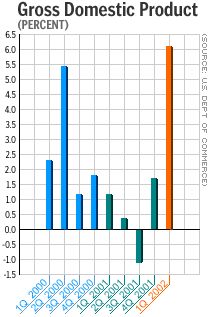
NEW YORK (CNN/Money) -
The U.S. economy grew at a much stronger pace in the first quarter than initially estimated, the government said Thursday, while a separate report showed weekly jobless claims falling again.
The Commerce Department said its final measure of U.S. gross domestic product (GDP) growth in the first quarter was 6.1 percent, compared with its prior estimate of 5.6 percent. Economists, on average, expected 5.6 percent growth, according to Briefing.com.
It was the strongest quarter for the economy since GDP grew at an 8.3 percent rate in the fourth quarter of 1999. GDP grew 1.7 percent in the fourth quarter of 2001.
"It's a healthy development," said Anthony Chan, chief economist at Banc One Investment Advisors. "It tells us the underlying momentum of the economy was stronger, so we can afford to take a bigger hit in the second quarter and still have respectable growth for the year."
Separately, the Labor Department said the number of Americans filing new claims for unemployment benefits fell to 388,000 in the week ended June 22 from a revised 398,000 the prior week. It was the fourth straight week that new claims were below 400,000, a level that points to a sluggish job market. Economists, on average, expected 390,000 new claims, according to Briefing.com.

U.S. stock prices rose after the data were released, but moved in and out of negative territory later in the morning. Treasury bond prices fell.
In perhaps the most surprising aspect of the GDP report, business spending was revised to a 6.2 percent decline from a previously estimated 8.2 percent drop, a much better performance than the fourth quarter's 13.8 percent decline.
Federal Reserve Chairman Alan Greenspan and other economists have said that business spending will be the key to the strength of the economy's recovery from a recession that began in March 2001. There have been hopeful signs of a turnaround recently, such as Wednesday's report from the Commerce Department showing strength in orders for durable goods.
"One of the biggest upward revisions was to investment spending on equipment, exactly the area we're worried about," Putnam Investments economist David Kelly said. "That grew marginally, and that's the start of something."
The biggest boost to GDP still came from business inventories, which shrank at a rate of $27.7 billion in the quarter, far below the $119.3 billion reduction in the fourth quarter.
The way the Commerce Department measures the change in inventories means that the $91.6 billion difference between the first and fourth quarters actually added to growth in the first quarter, since inventories shrank at a much slower rate, boosting GDP by nearly 3.4 percentage points.
Excluding the change in inventories, real sales of domestic product rose about 2.6 percent after increasing 3.8 percent in the fourth quarter.
"The first quarter was terrific, but it just shows you what happens when corporations go from inventory liquidation to actually just a more moderate pace of inventory growth," said Irwin Kellner, Weller professor of economics at Hofstra University and chief economist at North Fork Bank. "The key going forward is how sustainable the recovery will be."
Kellner said he expected second-quarter GDP growth of between 2.5 and 3.0 percent -- better than any quarter last year, but not exactly robust -- and other economists have picked even lower numbers.
In the first quarter, consumer spending continued to be the stalwart of the economy, growing at an upwardly revised rate of 3.3 percent, following a 6.1 percent gain in the fourth quarter. On an annualized basis, consumer spending makes up about $6.6 trillion of the nation's roughly $10 trillion economy.
The data followed Wednesday's decision by the Federal Reserve to leave its target for short-term interest rates at an already low level because of uncertainty about the strength of the economy going forward.
The Fed cuts rates to spur economic activity and raises them to slow the economy down and fight inflation. It has pointed out for several months that, while first-quarter GDP growth was strong, much of it was due to the shift in inventories and that strength in final demand is uncertain.
Adding to the uncertainty has been the turmoil in U.S. equity markets, driven by a wave of corporate scandals -- the latest of which was the revelation late Tuesday by WorldCom Group (WCOM: Research, Estimates) of accounting improprieties that altered the telecommunications company's financial position by some $4 billion.
| |
 Related links
Related links
| |
| | |
| | |
|
"Corporate profits have begun to rise, but if the stock market continues to fall, it might influence corporate spending because they won't be able to raise money via the equity market," Kellner said, "something many companies need to do because they are highly leveraged."
A damper on consumer spending going forward could be the sluggish recovery of the job market. Unemployment has hovered at or near 5.8 percent since December, and most economists think the Labor Department will say July 5 that unemployment crept up to 5.9 percent in June, according to Briefing.com.
In Thursday's jobless-claims report, the four-week moving average of jobless claims, which smoothes out fluctuations in the weekly data, fell to 391,000 in the week ended June 22 from a revised 397,500 the prior week.
Continued claims, the number of people who have been drawing unemployment benefits for more than a week, fell to 3.7 million in the week ended June 15, the latest data available, from 3.75 million the prior week.
"The labor market seems to be improving, but still at such slow pace, it's probably too early to start celebrating," Chan of Banc One said.

|

